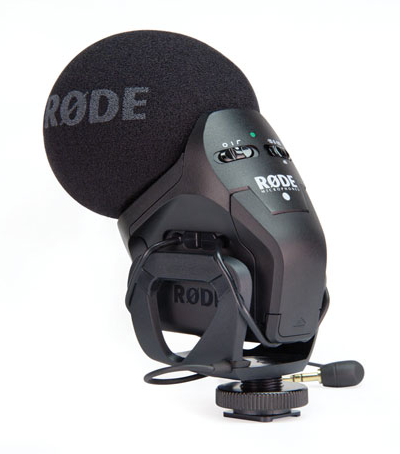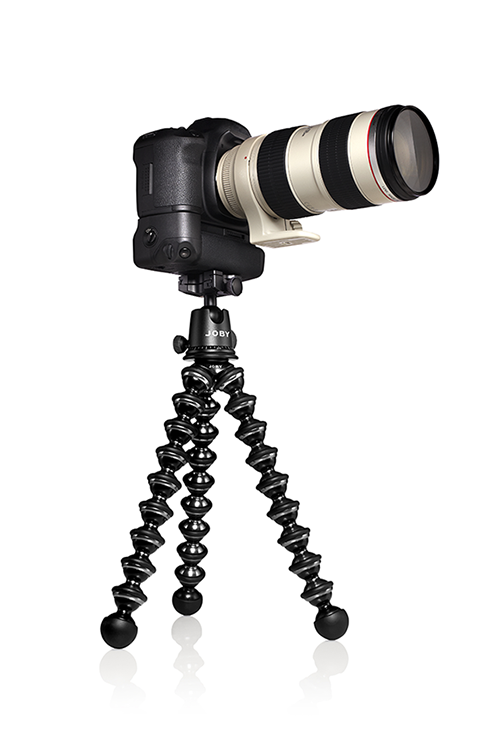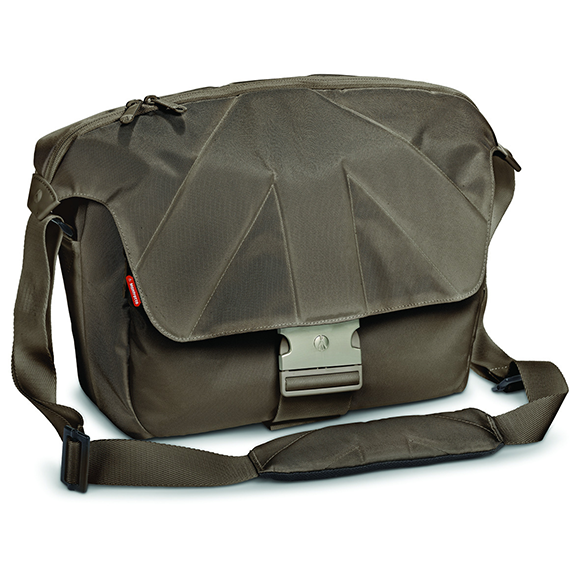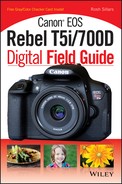Appendix B: Accessories
The Canon Rebel T5i/700D body is just a starting point. The list of accessories available for your camera is long and can get expensive quickly. It is important to think through your purchase decisions. The accessories you choose have a lot to do with the type of photography you want to pursue. For example, food photography requires different accessories than landscape work does. The best place to start is investing in quality lenses. A tripod is also a smart purchase for both still photography and video. If you plan to create serious videos, you will need support accessories, lights, and microphones. I like to purchase grips for my cameras because it makes them feel more solid, and they also hold two batteries for a longer shooting time. Finally, don’t forget that you need a camera bag to hold your equipment and keep it safe.
Grips and Remotes
A grip fits on the bottom of your camera and stores two batteries. It also adds weight to your camera, which some photographers consider a benefit because it makes it easier to balance. Remotes give you the ability to take long exposures (beyond the 30-second limit) with your camera. An intervalometer is a more advanced remote control that can be programmed to take multiple photographs over specific periods of time.
The Canon grip for your T5i/700D is the BG-E8. It is useful for several reasons. First, you can shoot more comfortably holding the camera vertically. The grip also holds two batteries, giving you longer battery power in the field. It also offers additional balance when handling your camera. To install a grip, you need to remove the battery door cover, as shown in Figure AB.1. Because the grip holds two batteries, you may want to purchase an additional LP-E8 battery pack.

Image courtesy of Canon
AB.1 This is the BG-E8 grip designed for the Canon Rebel T series cameras.
You can also use the BG-E8 grip on the Canon T2i, T3i, and T4i.
You can’t set an exposure time longer than 30 seconds on the Canon Rebel T5i/700D. The Bulb setting ( ![]() ) requires you to hold down the shutter manually as long as necessary. In some situations, such as when shooting the night sky, you can use your camera’s timer to take up to 10 images in a row, and then combine them later in a program like Adobe Photoshop.
) requires you to hold down the shutter manually as long as necessary. In some situations, such as when shooting the night sky, you can use your camera’s timer to take up to 10 images in a row, and then combine them later in a program like Adobe Photoshop.
Remotes make the process of shooting long exposures easier. The Canon RS-60E3 remote connects directly to the remote port on the left side of your camera. This is like having an external shutter button. Remotes — also known as cable releases — are also helpful for macro and night photography because they prevent camera shake when taking long exposures.

Image courtesy of Canon
AB.2 Use the RS-60E3 remote to keep the shutter open for long exposures.
The RC-6 is a small, infrared wireless remote used to avoid camera shake when shooting long exposures. Another benefit is that you can be in the photograph and wait until everyone in the group is ready before you take the picture. You have the choice of a 2-second delay, a 10-second delay, or taking the photo instantly. The delay gives you time to prepare yourself or quickly put the remote in a pocket. You can also easily stand up to 15 feet away from your camera to take a photograph. It’s a nice, inexpensive accessory to have in your bag.

Image courtesy of Canon
AB.3 The RC-6 is a small, infrared wireless remote for Canon cameras.
Video Accessories
Video accessories make creating movies easier and, in many cases, can make your video look more professional. The following list of accessories can help you create better videos:
• A steady camera. Keeping your camera steady is one of the tricks of creating good video. Begin with a tripod. When you need to be on the move, there are many options to handhold your camera. Some of these options, such as the Merlin 2 Steadicam, shown in Figure AB.4, are simple, handheld devices. Others require two hands, or that you rest your shoulders or your body. There are also rigs with monitor holders.

Image courtesy of Tiffen
AB.4 Tiffen’s Merlin 2 Steadicam is designed to be handheld for the photographer on the move.
• A loupe. A loupe magnifies the image on the camera’s LCD screen. Some of the more sophisticated models are found with viewing hoods, and the best have a diopter to help you see more clearly. A few companies that make loupes are Kalt, Peak, and Schneider.
• Lights. Good lighting accessories can drastically improve your videos. You have many choices, such as LEDs (light-emitting diodes), fluorescents, and HMIs (Hydrargyrum medium-arc iodide), to name a few. LEDs, like the Manfrotto 24 LED with a color temperature of 5600K, are good for short distances. They are a popular light source and usually fit in your camera’s hot shoe. LED kits often come with filters to match different lighting situations. HMI lights are much more powerful than LEDs, and are commonly used in movie and video production. However, if you like to use light boxes and umbrellas, I recommend using a fluorescent lighting kit.
For more detailed information about lighting, see Chapter 6.
• An LCD screen hood/shade. The LCD screen on the T5i is great until it meets bright sunlight, and then it disappears. If you are shooting stills, you can use the camera’s viewfinder to overcome this problem. If you are shooting video, however, you need a way to turn the back of your camera into a viewfinder so you can see your screen clearly. A screen hood blocks the sunlight so you can clearly see the camera’s LCD screen.

Image courtesy of Lowel
AB.5 The Lowel GL-1 Handheld LED can be used for video or still photography.
Microphones
For the casual user, your camera’s built-in microphone might do the trick. However, as mentioned previously, one of the most important elements of good video is good audio. I recommend that you invest in an external microphone. In-camera microphones traditionally don’t deliver the high-quality sound necessary for professional video production. While the T5i’s microphone and software are better than others, and you can make some adjustments in-camera, if you need high-quality video sound, an external microphone is the answer.

Image courtesy of Rode
AB.6 Rode makes a series of microphones, some of which are designed to fit in your camera’s hot shoe.
There are a number of models on the market, and most fall under one of the following three categories: Omnidirectional, bidirectional, or unidirectional. Each type has its advantages, depending on your needs. Omnidirectional microphones capture sound from all directions. This type of microphone also easily records ambient noise in the background (wanted or unwanted). A bidirectional microphone captures sound from two directions, and the unidirectional microphone records sound from one direction. Unidirectional mics come in multiple styles and are used for different purposes, each covering different angles or focus areas of sound capture.
A shotgun microphone is a common, all-purpose unidirectional microphone for subjects that are relatively close to the front of your camera. Many companies make shotgun microphones that connect to your camera’s hot shoe. For interviews, a handheld microphone is a good option for the photographer on the move. A lavalier microphone clips to the subject’s clothing and is often used for more static or formal interviews.

Image courtesy of Zoom
AB.7 The Zoom H2 digital recorder is small and easy to use.
If you want to achieve the best audio possible, consider using an external recording device in addition to a microphone. The combination of microphones and recording devices necessary depends on your goal. The downside of using an external recording device is that you must align the sound and video in the editing process. This is why you see clappers being used on movie sets — they help match the sound with the scene in editing. Many audio recorder manufacturers, like Zoom, make it easy to attach microphones to dSLR cameras.
Tripods
Tripods come in many sizes and shapes. A good tripod keeps your camera steady, while still offering the flexibility of smooth motion for actions like panning (following a moving object). The type of tripod you purchase depends on the type of images you like to create. Heavy tripods are good for the studio and long exposures. Lighter and portable tripods are helpful when you are on the move, such as when hiking or traveling.
How high your tripod should be is also an important consideration. All of this depends on what you plan to photograph. The heavier the tripod is, the steadier it will keep your camera. Heavy tripods and those made of higher-quality materials, such as carbon fiber, tend to cost more money, though. Less expensive tripods are usually made of aluminum, come in one piece, and have a tilt-and-pan-style head. These heads are not as flexible as the more versatile ball heads found on higher-quality tripods.
Usually, tripod companies require you to select a head separately. When selecting a head, make sure it has all of the features that you need. Some things to consider include smooth movement, ease of adjustment, and a quality plate that is easy to connect to your camera and tripod head. If you are a photographer on the go, such as a sports photographer, consider using a monopod. A monopod has only one leg, and allows you to be mobile while offering the support necessary for long lenses.

Image courtesy of Manfrotto
AB.8 This series 290 Manfrotto Tripod kit is fine for casual use.
Occasionally, you may not have a tripod available. In these situations, a handbag, backpack, or clothing can support your camera on top of a wall, fence, or a rock. A small, flexible tripod, like the Gorillapod shown in Figure AB.9, is good to keep in your bag for when you don’t have a full-size tripod available. I have had many tripods throughout my career, and those that I invested some money in are still in great working order.

Image courtesy of Joby
AB.9 Gorillapods are light, flexible, and ideal when you don’t want to carry a lot of equipment.
Bags
Make sure that you have a good bag, pack, or case to protect and carry your gear. It is nice to have many pockets, but my biggest concern is ease of use. How easily and quickly can you grab equipment when you need it? Also, consider whether the bag is weatherproof and durable. Is it designed for the type of photography you are going to be doing? A photojournalist needs a different bag than a commercial photographer working in the studio does.
Commerical photographers often use hard cases to protect their equipment in storage and transit. Standard shoulder bags have a lot of pockets and are good for the photographer on the move who needs multiple lenses, filters, and small support tools. Messenger bags, like the one shown in Figure AB.10, with their simple design and ease of use, are popular with photographers. If you are a travel, nature, or wildlife photographer, you might want to consider a backpack-style bag.

Image courtesy of Manfrotto
AB.10 Messenger-style bags are preferred by many travel and wildlife photographers.
Reflectors are handy as an extra source of light to fill in shadows. Some reflectors are designed to turn into light modifiers and they fit on a flash, hotlight, or external strobe. Here, my focus is on handheld and collapsible reflectors. They come in many sizes and reflective colors. The color of a reflector is the color that reflects back onto your subject. For example, soft white reflects softer light onto your subject, while light from a gold reflector is warmer. Often, reflectors have different colors on each side, such as silver and gold, as shown in Figure AB.11. Some reflectors are also light diffusors, which are convenient for softening sunlight on bright summer days — I find them particularly handy when shooting on location.

Image courtesy of Westcott
AB.11 This reflector is collapsible, and is gold on one side and silver on the other.
Additional accessories you might consider are light modifiers to focus light, colored gels, or backdrops to create formal portraits. Extra stands are useful for rigging external lighting and holding accessories. I like to keep some extra heavy-duty clamps, like those shown in Figure AB.12, in my bag at all times because they have many uses, including holding reflectors to stands and pinning clothing in place.

AB.12 You can find clamps like these at most hardware stores.
